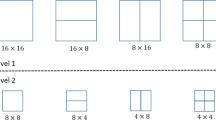Abstract
Video has become an important cover for steganography for its large volume. There are two main categories among existing methods for detecting steganography which embeds in the spatial domain of videos. One category focuses on the spatial redundancy and the other one mainly focuses on the temporal redundancy. This paper presents a novel method which considers both the spatial and the temporal redundancy for video steganalysis. Firstly, model of spread spectrum steganography is provided. PEF (Prediction Error Frame) is then chosen to suppress the temporal redundancy of the video content. Differential filtering between adjacent samples in PEFs is employed to further suppress the spatial redundancy. Finally, Dependencies between adjacent samples in a PEF are modeled by a first-order Markov chain, and subsets of the empirical matrices are then employed as features for a steganalyzer with classifier of SVM (Support Vector Machine). Experimental results demonstrate that for uncompressed videos, the novel features perform better than previous video steganalytic works, and similar to the well-known SPAM (Subtractive Pixel Adjacency Model) features which are originally designed for image steganalysis. For videos compressed with distortion, the novel features perform better than other features tested.









Similar content being viewed by others
References
Aly H (2011) Data hiding in motion vectors of compressed video based on their associated prediction error. IEEE Trans Inf Forensic Secur 6(1):14–18
Budhia U, Kundur D (April, 2004) “Digital video steganalysis exploiting collusion sensitivity”, “Sensors, Command. Control, Communications, and Intelligence(C3I) Technologies for Homeland Security and Homeland Defense”, Edward M. Carapezza, ed., Proc. SPIE, vol. 5403
Budhia U, Kundur D, Zourntos T (2006) Digital video steganalysis exploiting statistical visibility in the temporal domain. IEEE Trans Inf Forensic Secur 1(1):43–55
Cao Y, Zhao X, Feng D (2012) Video steganalysis exploiting motion vector reversion-based features. IEEE Signal Process Lett 19(1):35–38
Chang CC and Lin CJ “LIBSVM: a library for support vector machines”[Online]. Available: http://www.csie.ntu.edu.tw/~cjlin/libsvm
Cox J, Kilian J, Leighton T, Shamoon T (1997) Secure spread spectrum Watermarking for Multimedia. IEEE Trans Image Process 6(12):1673–1687
FFMPEG Library[Online], Available: http://ffmpeg.sourceforge.net/
Hartung F, Girod B (May 1998) “Watermarking of uncompressed and compressed video”, Signal Processing, Special Issue on Copyright Protection and Access Control for Multimedia Services,66(3):283–301
Jainsky JS, Kundur D, Halverson DR (September 2007) “Towards Digital Video Steganalysis using Asymptotic Memoryless Detection”, Proc. ACM MM&Sec’07, Dallas, Texas, USA, pp. 161–168
Kanchela K, Mukkamala S (June, 2009) “Video Steganalysis using Motion Estimation”, Proc. of International Joint Conference on Neural Networks, Atlanta, Georgia, USA, pp. 1510–1515
Kancherla K, Mukkamala S (2009) “Video Steganalysis Using Spatial and Temporal Redundancies”, Proc. International Conference on High Performance Computing&Simulation, pp. 200–207
Kashyap S, Bora PK (2010) “Spatial Averaging based Steganalysis Scheme to detect Antipodal Watermarks”, pp. 1–5
Li Q, Cox IJ (2007) Using perceptual models to improve fidelity and provide resistance to valumetric scaling for quantization index modulation watermarking. IEEE Trans Inf Forensic Secur 2(2):127–139
Liu B, Liu F, Yang CF (2008) “Stepwise inter-frame correlation-based steganalysis system for video streams”, Security and Communication Networks, Security Comm. Networks, pp. 487–494
Liu Q, Sung AH, Qiao M (2008) “Video steganalysis based on the expanded Markov and joint distribution on the transform domains—Detecting MSU StegoVideo”, in Proc. 7th International Conference on Machine Learning, and Applications, pp. 671–674
Marvel LM, Boncelet CG, Retter CT (1999) Spread spectrum image steganography. IEEE Trans Image Process 8(8):1075–1083
MSUStegovideo[Online], Available: http://compression.ru/video/stego_video/index_en.html.
Pankajakshan V, Doërr G, Bora PK (2009) Detection of motion-incoherent components in video streams. IEEE Trans Inf Forensic Secur 4(1):49–58
Pérez-González F, Barni M, Abrardo A, Mosquera C (2004) “Rational Dither Modulation: A Novel Data-Hiding Method Robust to Value-metric Scaling Attacks”, IEEE 6th Workshop on Multimedia Signal Processing, pp. 139–142
Pevný T, Bas P, Fridrich J (2010) Steganalysis by subtractive pixel adjacency matrix. IEEE Trans Inf Forensic Secur 5(2):215–224
Pevný T, Bas P, Fridrich J (September, 2009) “Steganalysis by subtractive pixel adjacency matrix”, in Proc. 11th ACM Multimedia &Security Workshop, Princeton, NJ, pp. 75–84
Pevný T, Fridrich J (February, 2007) “Merging Markov and DCT Features for Multi-Class JPEG Steganalysis”, in Proc. SPIE, Electronic Imaging, Security, Steganography, and Watermarking of Multimedia Contents IX, San Jose, CA, 6505:301–314
Rana V, Mishra R, Bora PK, Kashyap S (2008) “Novel Scheme of Video Steganalysis for Detecting Antipodal Watermarks”, Proc. IEEE Region 10 Conference-TENCON, pp. 1–5
Sharp T (2001) “An implementation of key-based digital signal Steganography”, in: Proc. 4th Information Hiding Workshop. Lect Notes Comput Sci 2137:13–26
Su Y, Zhang C, Zhang C (2011) A video steganalytic algorithm against motion-vector-based steganography. Signal Process 91(8):1901–1909
VCDemo: Image and Video Compression Learning Tool. [Online]. Available: http://ict.ewi.tudelft.nl/~inald/vcdemo
Zhang T, Li W, Zhang Y, Zheng E, Ping X (2010) Steganalysis of LSB matching based on statistical modeling of pixel difference distributions. Inf Sci 180:4685–4694
Zhang C, Su Y, Zhang C (2008) Video steganalysis based on aliasing detection. Elec Lett 44(13):801–803
Acknowledgments
This research was supported by the National Natural Science Foundation of China (NSFC) under the grant No. 61170226, the Fundamental Research Funds for the Central Universities under the grant Nos.SWJTU11CX047, and Chengdu Science and Technology program under the grant No. 12DXYB214JH-002.
Author information
Authors and Affiliations
Corresponding author
Rights and permissions
About this article
Cite this article
Wang, K., Han, J. & Wang, H. Digital video steganalysis by subtractive prediction error adjacency matrix. Multimed Tools Appl 72, 313–330 (2014). https://doi.org/10.1007/s11042-013-1373-4
Published:
Issue Date:
DOI: https://doi.org/10.1007/s11042-013-1373-4




